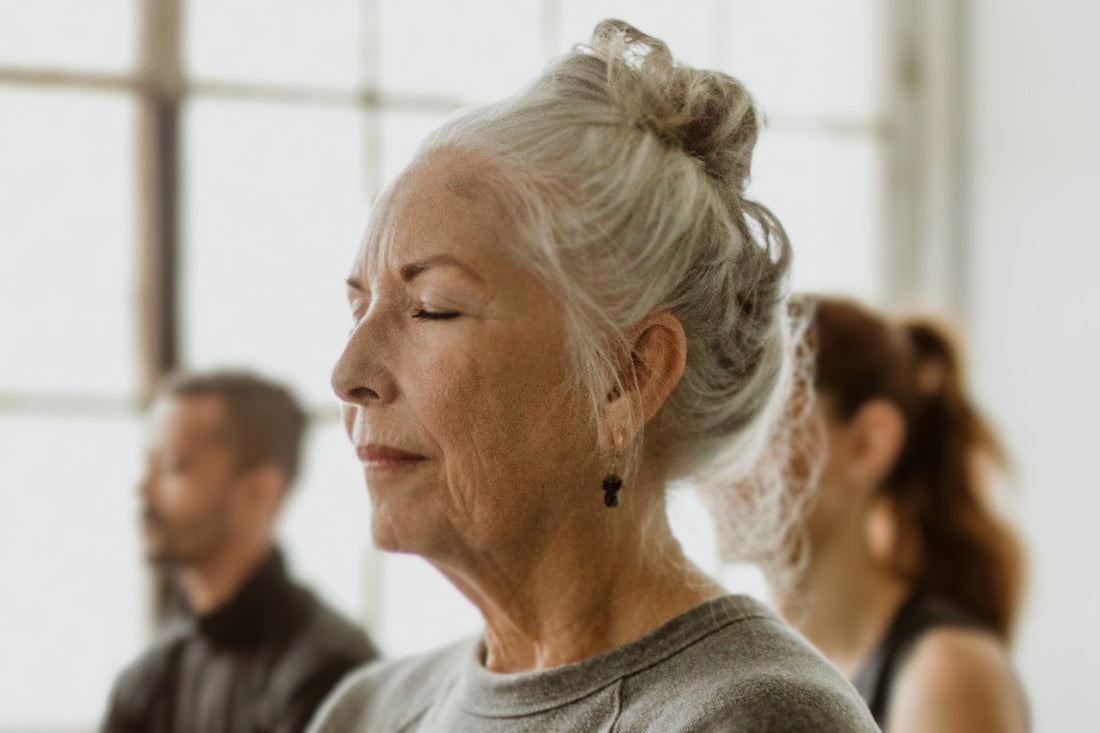
These are the Top Breathing Strategies for COPD
Share
Breathing Strategies for COPD: Overcoming Breathlessness and Anxiety
One of the biggest challenges of living with chronic obstructive pulmonary disease (COPD) is the shortness of breath that can happen each day.
If you have COPD, you also may notice that sometimes when you experience breathlessness, you become anxious, too. Read on to understand how to break the dyspnea cycle and improve your well-being.
Table of Contents
Summary Points:
- Pursed Lip Breathing: Helps reduce anxiety and regulate breathing by lengthening exhalation, promoting relaxation, and improving oxygen exchange.
- Diaphragmatic Breathing: Strengthens the diaphragm, improving lung efficiency and reducing shortness of breath. This technique is particularly beneficial for individuals with COPD.
- Controlled Coughing: Helps clear mucus from the lungs without excessive fatigue. It also provides a sense of control over the coughing process, which is important for COPD patients.
- Deep Breathing: Reduces stress, promotes calmness, and enhances lung function by focusing on slow, deep breaths. It also helps manage anxiety and improves overall well-being.
- Coordinated Breathing: Ties breathing to movement, improving stamina and reducing anxiety during physical activities, such as lifting or climbing stairs.
- Huff Coughing: Aids in mucus clearance, reducing the need for excessive coughing while conserving energy. This technique is useful for preventing further lung congestion.
Your Physiological & Psychological Response with Breathlessness
Breathlessness doesn’t just impact you physiologically; it also affects your psychological well-being. When you start to feel breathless, you avoid activities that make you feel that way. This leads to weakened muscles, reduced fitness, and an inability to effectively handle oxygen in your bloodstream. Sharon Noelker, a respiratory therapist, explains the link between physical deconditioning and psychological distress.
“Muscles need work—and they need work to run efficiently. When they don't run efficiently, they need more oxygen. And if you can't supply it, because your lungs aren't working efficiently, you do less.”
Breathing Strategies for COPD
Sharon shares a number of strategies she uses with her COPD patients to improve lung function and reduce stress. These strategies can help break the dyspnea cycle, reduce anxiety, and promote relaxation.
Pursed Lip Breathing
Pursed lip breathing is an extremely effective strategy that helps people reduce anxiety, calm down, and better regulate their breathing. It also releases serotonin, reducing stress and promoting relaxation.
To practice pursed lip breathing:
- Start with your back straight.
- Inhale through your nose for two seconds, engaging your diaphragm.
- Purse your lips and exhale slowly for four seconds (twice as long as the inhale).
- Repeat 5 times, 4-5 times a day.
Diaphragmatic Breathing
Diaphragmatic breathing is helpful for strengthening the diaphragm and improving air intake. It helps with breathing efficiency and reduces feelings of breathlessness.
To practice diaphragmatic breathing:
- Ensure you are in a comfortable position with your shoulders relaxed.
- Place one hand on your chest and the other on your abdomen.
- Breathe in deeply through your nose, allowing your belly to rise while keeping your chest still.
- Exhale and let your abdominal muscles tighten, returning your hand to its starting position.
- Repeat 5 times, 3-4 times a day.
Controlled Coughing
Controlled coughing helps clear mucus from the lungs without causing excessive fatigue. It’s particularly helpful for people with chronic bronchitis or excess mucus in the airways.
To practice controlled coughing:
- Sit with both feet on the floor and lean slightly forward.
- Fold your arms across your abdomen and breathe in through your nose.
- Exhale and cough 2-3 times, using short, controlled breaths.
- Gently breathe in again through your nose and repeat the process.
Deep Breathing
Deep breathing reduces stress and promotes calmness. It allows you to follow a different breathing rhythm to improve lung function and relaxation.
To practice deep breathing:
- Find a comfortable position, with your shoulders relaxed.
- Place one hand on your belly and the other on your chest.
- Breathe in deeply through your nose, filling your belly with air.
- Exhale slowly, allowing your belly to deflate.
- Repeat the technique 5 times, 3-4 times a day.
Coordinated Breathing
Coordinated breathing ties your breath to movement, especially during physical activity like lifting or climbing stairs.
To practice coordinated breathing:
- Inhale through your nose before starting activity.
- Exhale through pursed lips during the movement or exercise.
- Pause to inhale again during rest periods.
- Repeat this coordinated cycle during activity.
Huff Coughing Technique
Huff coughing helps move mucus out of the lungs while reducing fatigue from excessive coughing.
To practice huff coughing:
- Sit up straight and tilt your chin slightly to open your throat.
- Take three diaphragmatic breaths, then hold the third one for three seconds.
- Exhale forcefully through an open mouth, whispering the word "HA."
- Repeat 3 huff cough maneuvers, then rest.
PEP Buddy: Better Breathing, Backed By Science
PEP Buddy is a simple, portable, clinically proven medical device that reduces breathlessness, allowing you to increase your activity level. PEP Buddy also helps prevent significant declines in blood oxygen levels during activity.
Learn more about easing your shortness of breath with PEP Buddy today.This blog is for educational purposes only; talk to your provider to understand recommendations specific to you.
Summary Points:
- Pursed Lip Breathing: Reduces anxiety, improves breathing control, and releases serotonin to help you relax.
- Diaphragmatic Breathing: Strengthens the diaphragm, improves lung capacity, and reduces shortness of breath.
- Controlled Coughing: Clears mucus from the lungs efficiently without causing exhaustion.
- Deep Breathing: Reduces stress, promotes relaxation, and improves lung function.
- Coordinated Breathing: Ties breathing to movement, improving stamina and reducing anxiety during physical activities.
- Huff Coughing: Aids in mucus clearance, reducing fatigue from excessive coughing.
